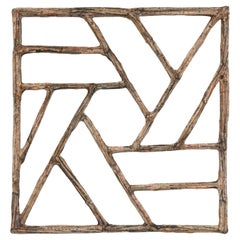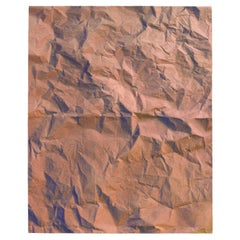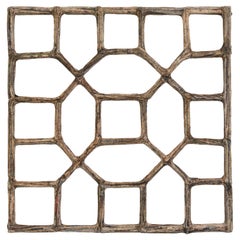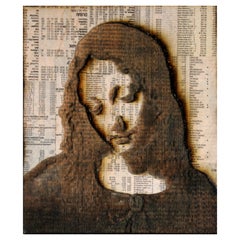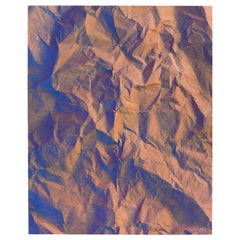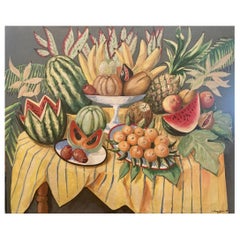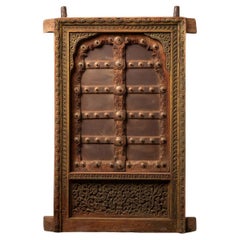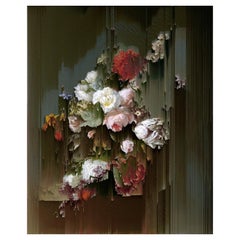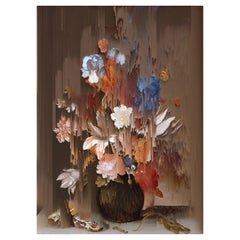Gordon Cheung Contemporary Art
7
to
7
7
7
7
7
Height
to
Width
to
3
3
3
3
2
6
6
6
7
126
77
37
37
Creator: Gordon Cheung
"Window A #49" by Gordon Cheung
By Gordon Cheung
Located in Atlanta, GA
Artwork by Gordon Cheung, "Window A #49" sculpted with Bamboo, the Financial Times and adhesive, 2020
Windows
Traditional Chinese windows made from financial newspaper and bamb...
Category
2010s Gordon Cheung Contemporary Art
Materials
Paper, Bamboo
"Migration Screw #4" by Gordon Cheung
By Gordon Cheung
Located in Atlanta, GA
"Migration (Screw #4)", 2014, Financial newspaper collage, acrylic on canvas and board, 50 x 40 x 2.5cm
by Gordon Cheung
Screw Paintings
Begun around 2014 they were originally...
Category
2010s English Gordon Cheung Contemporary Art
Materials
Canvas, Acrylic
"Still Life with Flowers and Fruit after Jan Evert Morel I" by Gordon Cheung
By Gordon Cheung
Located in Atlanta, GA
Artwork by Gordon Cheung, "New Order Still Life with Flowers and Fruit (after Jan Evert Morel I, 1800-1808)", 2021, giclee on canvas
This pieces is ...
Category
2010s English Gordon Cheung Contemporary Art
Materials
Canvas
"Window B #50" by Gordon Cheung
By Gordon Cheung
Located in Atlanta, GA
Artwork by Gordon Cheung, "Window B #50" sculpted with Bamboo, the Financial Times and adhesive, 2020
Windows
Traditional Chinese windows made from financial newspaper and bamb...
Category
2010s English Gordon Cheung Contemporary Art
Materials
Paper, Bamboo
"Mother" by Gordon Cheung
By Gordon Cheung
Located in Atlanta, GA
Artwork by Gordon Cheung, Mother, 2009, Laser pyrography, vaporised stock listings on plywood, 21 x 17 x 2cm
The laser pyrographic etchings are layered with financial newspaper be...
Category
Early 2000s English Gordon Cheung Contemporary Art
Materials
Wood
"Castles Cascade to Sand Screw #5" by Gordon Cheung
By Gordon Cheung
Located in Atlanta, GA
"Castles Cascade to Sand (Screw #5)", 2014, Financial newspaper collage, acrylic on canvas and board, 50 x 40cm
by Gordon Cheung
Screw Paintings
Begun around 2014 they were or...
Category
2010s English Gordon Cheung Contemporary Art
Materials
Acrylic, Canvas
"Window N #62" by Gordon Cheung
By Gordon Cheung
Located in Atlanta, GA
Artwork by Gordon Cheung, sculpted with Bamboo, the Financial Times and adhesive, 2020
Windows
Traditional Chinese windows made from financial newspaper and bamboo refer to hom...
Category
2010s English Gordon Cheung Contemporary Art
Materials
Paper, Bamboo
Related Items
"Caribbean Still Life" by Jacques Lamy
By Jacques Lamy
Located in Dallas, TX
Original painting by French-American artist Jacques Lamy, acquired through a local Dallas estate where the artist resided.
Large contemporary painting is in pristine, unaltered con...
Category
21st Century and Contemporary American Gordon Cheung Contemporary Art
Materials
Canvas
19th century antique wooden Indian window frame - OriginalBuddhas
Located in DEVENTER, NL
This antique wooden Indian window frame holds a captivating history within its design. Crafted from wood, it stands at a height of 78 cm with dim...
Category
19th Century Indian Antique Gordon Cheung Contemporary Art
Materials
Wood
Free Shipping
H 30.71 in W 20.67 in D 3.94 in
Large Autumnal Citrus and Vessels Abstract Still Life Oil Painting, Framed
Located in Morristown, NJ
Francois Heaulme (French, 1927-2005), Large framed still life with oranges, pottery and bottles, signed lower left.
Dimensions:
57"h x 37.5"w (sig...
Category
Late 20th Century French Modern Gordon Cheung Contemporary Art
Materials
Canvas, Wood, Paint
Still Life with Italian Bowl, Life Mask, Peach and iPod, Original Oil Painting
By Andrew S. Conklin
Located in Chicago, IL
This still life painting on panel captures a variety of objects. Among the objects depicted are a beautiful venetian glass bowl, a cup of Italian gelato, a ripe peach, a white life mask and an obsolete iPod all placed upon a table. These masterfully painted objects create a tableau of our times. This artwork is framed in a simple antiqued silver wooden frame measuring 8.75 H x 14.75 W inches.
Andrew S. Conklin
Still life with Italian bowl, life mask, peach and iPod
Oil on panel
Measures: 7.50 H x 13.50 W in
19.05 H x 34.29 W cm
ACK036
Andrew S. Conklin
Andrew S. Conklin is a figurative painter. He holds an MFA from the Academy of Art University, and studied painting at the National Academy of Design in New York City with Harvey Dinnerstein...
Category
2010s American Mid-Century Modern Gordon Cheung Contemporary Art
Materials
Paint
H 7.5 in W 13.5 in D 1.5 in
Original Abstract Composition by C. Azuelos, Imaginary Window
Located in Miami, FL
Beautiful abstract composition example of the artist’s work, original color painting on paper by C. Azuelos.
Wonderfully decorative original with so much movement to be interrupted...
Category
20th Century French Mid-Century Modern Gordon Cheung Contemporary Art
Materials
Paper
"Denkbilder" by Patrick Fitzgerald
By Patrick Fitzgerald
Located in Chicago, IL
To Chicago-based artist Patrick Fitzgerald, his miniature car sculptures are a means of traveling through time. Born from a fascination with the soap box derby cars of his youth, eac...
Category
21st Century and Contemporary American Industrial Gordon Cheung Contemporary Art
Materials
Canvas, Wood, Paint, Paper
André Derain Framed 'Fish and Still Life' Color Lithography, circa 1970
By André Derain
Located in Barcelona, Barcelona
Original 'Fish and still life' color lithograph by André Derain.
Lithograph printed from an original painting made by the author in France, circa 1939.
Published by Mourlot in Collection Pierre Levy in 1970, Paris.
Framed and signed in the stone.
In good original condition, with minor wear consistent with age and use, preserving a beautiful patina.
About the Artist:
André Derain (10 June 1880 – 8 September 1954) was a French artist, painter, sculptor and co-founder of Fauvism with Henri Matisse.
Derain and Matisse worked together through the summer of 1905 in the Mediterranean village of Collioure and later that year displayed their highly innovative paintings at the Salon d'Automne. The vivid, unnatural colors led the critic Louis Vauxcelles to derisively dub their works as les Fauves, or "the wild beasts", marking the start of the Fauvist movement. In March 1906, the noted art dealer Ambroise Vollard sent Derain to London to produce a series of paintings with the city as subject. In 30 paintings (29 of which are still extant), Derain presented a portrait of London that was radically different from anything done by previous painters of the city such as Whistler or Monet. With bold colors and compositions, Derain painted multiple pictures of the Thames and Tower Bridge. These London paintings remain among his most popular work. Art critic T. G Rosenthal: "Not since Monet has anyone made London seem so fresh and yet remain quintessentially English.
Some of his views of the Thames use the Pointillist technique of multiple dots, although by this time, because the dots have become much larger, it is rather more simply the separation of colours called Divisionism and it is peculiarly effective in conveying the fragmentation of colour in moving water in sunlight."
He experimented with stone sculpture and moved to Montmartre to be near his friend Pablo Picasso and other noted artists. Fernande Olivier...
Category
1970s French Modern Vintage Gordon Cheung Contemporary Art
Materials
Paper
No Reserve
H 23.63 in W 26.97 in D 0.79 in
"Blue Kimono" by Gordon Chandler
By Gordon Chandler
Located in Chicago, IL
Upon discovering a weathered steel drum that had been warped to resemble the sleeve of a garment, artist Gordon Chandler was inspired to embark on a series of kimono sculptures forme...
Category
21st Century and Contemporary American Industrial Gordon Cheung Contemporary Art
Materials
Steel
Dog Painting & Collage on Vintage Window
Located in Hopewell, NJ
"Dogs I Know" is a collection of dog portraits painted reverse on the back of a vintage glass window. Each pets name is inscribed on the front of...
Category
Late 20th Century American Gordon Cheung Contemporary Art
Materials
Acrylic
Contemporary Still Life with Alexander The Great Bust and Orange Apple iBook
By Andrew S. Conklin
Located in Chicago, IL
Still Life painting, with origins dating back to the 16th century, often depicts simple everyday objects. Conklin sets his composition with both antiquities and modern elements to bring the Still Life genre into the contemporary. Yet when a closer look is taken, his modern elements are already obsolete by today's standards. The ancient bust of Alexander is placed next to an iBook begging to ask the question - what will stand the test of time?? The piece is framed in a simple walnut frame measuring 26 x 26 inches.
Andrew S. Conklin
Square still life with Alexander Bust and ibook
oil on linen
Measures: 25 H x 25 W in
63.50 H x 63.50 W cm
ACK038
Andrew S. Conklin
Andrew S. Conklin is a figurative painter. He holds an MFA from the Academy of Art University, and studied painting at the National Academy of Design in New York City with Harvey Dinnerstein...
Category
2010s American Mid-Century Modern Gordon Cheung Contemporary Art
Materials
Paint, Linen
Donna Schuster “Mother and Child” Watercolor, Pencil and Gouache
By Donna N. Schuster 1
Located in Los Angeles, CA
Donna schuster (1883-1953) “Mother and Child” watercolor, pencil and gouache within a giltwood carved frame and protective glass. Signed ‘Donna Schuster’ (Lower Right), circa 1920-19...
Category
20th Century American American Classical Gordon Cheung Contemporary Art
Materials
Glass, Wood
Cubist Still Life "Violin" by Agnes Weinrich, Signed, Dated 1922
By Agnes Weinrich
Located in New York, NY
Still life painting (Violin, Flowers), Oil on canvas, by Agnes Weinrich, Signed and dated "22", Unframed: 20" x 16", Framed 27.5 x 23".
Agnes Weinrich (1873-1946) was an early female, American modernist artist at a time when there was little interest in Modern Art in the USA and when few women were artists. She was a ground breaker in modern art. The painting shown is an important example of her mature phase of her work.
A biography from Wiki-pedia follows:
Agnes Weinrich (1873–1946) was one of the first American artists to make works of art that were modernist, abstract, and influenced by the Cubist style. She was also an energetic and effective proponent of modernist art in America, joining with like-minded others to promote experimentation as an alternative to the generally conservative art of their time.
Early years[edit]
Agnes Weinrich was born in 1873 on a prosperous farm in south east Iowa. Both her father and mother were German immigrants and German was the language spoken at home. Following her mother's death in 1879 she was raised by her father, Christian Weinrich. In 1894, at the age of 59, he retired from farming and moved his household, including his three youngest children—Christian Jr. (24), Agnes (21), and Lena (17), to nearby Burlington, Iowa, where Agnes attended the Burlington Collegiate Institute from which she graduated in 1897.[1][2][3] Christian took Agnes and Lena with him on a trip to Germany in 1899 to reestablish links with their German relatives. When he returned home later that year, he left the two women in Berlin with some of these relatives, and when, soon after his return, he died, they inherited sufficient wealth to live independently for the rest of their lives.
Either before or during their trip to Germany Lena had decided to become a musician and while in Berlin studied piano at the Stern Conservatory. On her part, Agnes had determined to be an artist and began studies toward that end at the same time.[1][4] In 1904 the two returned from Berlin and settled for two years in Springfield, Illinois, where Lena taught piano in public schools and Agnes painted in a rented studio. At this time Lena changed her name to Helen. In 1905 they moved to Chicago where Agnes studied at the School of the Art Institute of Chicago under John Vanderpoel, Nellie Walker, and others.[1]
In 1909 Agnes and Helen returned to Berlin and traveled from there to Munich, where Agnes studied briefly under Julius Exter, and on to Rome, Florence, and Venice before returning to Chicago.[5] They traveled to Europe for the third, and last, time in 1913, spending a year in Paris. There, they made friends with American artists and musicians who had gathered there around the local art scene. Throughout this period, the work Agnes produced was skillful but unoriginal—drawings, etching, and paintings in the dominant academic and impressionist styles.[1]
On her return from Europe in 1914, she continued to study art, during the warm months of the year in Provincetown, Massachusetts,[1] where she was a member of the Provincetown Printers art colony in Massachusetts,[6] and during the colder ones in New York City. In Provincetown she attended classes at Charles Hawthorne's Cape Cod School of Art and in New York, the Art Students League.[1]
Drawing of an old woman by Agnes Weinrich, graphite on paper, 11.5 x 7.5 inches.
Hawthorne and other artists established the Provincetown Art Association in 1914 and held the first of many juried exhibitions the following year. Weinrich contributed nine pictures to this show, all of them representational and somewhat conservative in style.[1]
A pencil sketch made about 1915 shows a figure, probably one of the Portuguese women of Provincetown. Weinrich was a metculous draftsperson and this drawing is typical of the work she did in the academic style between 1914 and 1920. She also produced works more akin to the Impressionist favored by Hawthorne and many of his students. When in 1917 Weinrich showed paintings in a New York women's club, the MacDowell Club, the art critic for the Brooklyn Daily Eagle said they showed a "strong note of impressionism."[7]
Broken Fence by Agnes Weinrich, a white-line woodblock made on or before 1917; at left: the woodblock itself; at right: a print pulled from the woodblook.
In 1916 Weinrich joined a group of printmakers which had begun using the white-line technique pioneered by Provincetown artist B.J.O. Nordfelt. She and the others in the group, including Blanche Lazzell, Ethel Mars and Edna Boies Hopkins, worked together, exchanging ideas and solving problems.[1][8] A year later Weinrich showed one of her first white-line prints at an exhibition held by the Pennsylvania Academy of Fine Arts in Philadelphia.[9]
Broken Fence, in its two states—the print and the woodblock from which she made it—show Weinrich to be moving away from realistic presentation, towards a style, which, while neither abstract, nor Cubist, brings the viewer's attention to the flat surface plane of the work with its juxtaposed shapes and blocks of contrasting colors.
Cows Grazing in the Dunes near Provincetown by Agnes Weinrich, white-line woodcut, 10 x 10 1/2 inches
When in 1920 the informal white-line printmakers' group organized its own exhibition, Weinrich showed a dozen works, including one called Cows Grazing in the Dunes near Provincetown. This print shows greater tendency to abstraction than eitherBroken Fence or the prints made by other Provincetown artists of the time. The cows and dunes are recognizable but not presented realistically. The white lines serve to emphasize the blocks of muted colors which are the print's main pictorial elements. Weinrich uses the texture of the wood surface to call attention to the two-dimensional plane—the paper on which she made the print—in contrast with the implicit depth of foreground and background of cows, dunes, and sky. While the work is not Cubist, it has a proto-Cubist feel in a way that is similar to some of the more abstract paintings of Paul Cézanne.[10]
By 1919 or 1920, while still spending winters in Manhattan and summers on Cape Cod, the sisters came to consider Provincetown their formal place of residence.[1][11][12][13] By that time they had also met the painter, Karl Knaths. Like themselves a Midwesterner of German origin who had grown up in a household where German was spoken, he settled in Provincetown in 1919. Agnes and Knaths shared artistic leanings and mutually influenced each other's increasing use of abstraction in their work.[1][14]
The sisters and Knaths became close companions. In 1922 Knaths married Helen and moved into the house which the sisters had rented. He was then 31, Helen 46, and Agnes 49 years old. When, two years later, the three decided to become year-round residents of Provincetown, Agnes and Helen used a part of their inheritance to buy land and materials for constructing a house and outbuildings for the three of them to share. Knaths himself acquired disused structures nearby as sources of lumber and, having once been employed as a set building for a theater company, he was able to build their new home.[15]
Weinrich was somewhat in advance of Knaths in adopting a modernist style. She had seen avant-garde art while in Paris and met American artists who had begun to appreciate it. On her return to the United States she continued to discuss new theories and techniques with artists in New York and Provincetown, some of whom she had met in Paris. This loosely-knit group influenced one another as their individual styles evolved. In addition to Blance Lazzell, already mentioned, the group included Maude Squires, William Zorach, Oliver Chaffee, and Ambrose Webster. Some of them, including Lazzell and Flora Schofield had studied with influential modernists in Paris and most had read and discussed the influential Cubist and Futurist writings of Albert Gleizes and Gino Severini.[16][17]
Mature style[edit]
Woman with Flowers by Agnes Weinrich, circa 1920, oil on canvas, 34 x 30 1/4 inches, exhibited at the Provincetown Art Association exhibition of 1920, made available courtesy of the Association.
Two of Weinrich's paintings, both produced about 1920, mark the emergence of her mature style. The first, Woman With Flowers, is similar to one by the French artist, Jean Metzinger called Le goûter (Tea Time) (1911).[18]
Red Houses by Agnes Weinrich, circa 1921, oil on canvas on board, 24.25 x 25.5 inches; exhibited "Red Houses" at Fifth Annual Exhibition of the Society of Independent Artists.
Like much of Metzinger's work, Le goûter was discussed in books and journals of the time—including one called Cubism co-authored by Metzinger himself.[19] Because the group with which Weinrich associated read about and discussed avant-garde art in general and Cubism in particular, it is reasonably likely that Weinrich was familiar with Metzinger's work before she began her own.
The second painting, Red Houses, bears general similarity to landscapes by Cézanne and Braque. Both paintings are Cubist in style. However, with them Weinrich did not announce an abrupt conversion to Cubism, but rather marked a turning toward greater experimentation. In her later work she would not adopt a single style or stylistic tendency, but would produce both representative pictures and ones that were entirely abstract, always showing a strong sense of the two-dimensional plane of the picture's surface. After she made these two paintings neither her subject matter nor the media she used would dramatically change. She continued to employ subjects available to her in her Provincetown studio and the surrounding area to produce still lifes, village and pastoral scenes, portraits, and abstractions in oil on canvas and board; watercolor, pastel, crayon and graphite on paper; and woodblock prints.[20]
Possessing an outgoing and engaging personality and an active, vigorous approach to life, Weinrich promoted her own work while also helping Karl Knaths to develop relationships with potential patrons, gallery owners, and people responsible for organizing exhibitions. With him, she put herself in the forefront of an informal movement toward experimentation in American art. Since, because of her independent means, she was not constrained to make her living by selling art, she was free to use exhibitions and her many contacts with artists and collectors to advance appreciation and understanding of works which did not conform to the still-conservative norm of the 1920s and 1930s.[1][21][22]
Early in the 1920s, critics began to take notice of her work, recognizing her departure from the realism then prevailing in galleries and exhibitions. Paintings that she showed in 1922 drew the somewhat dry characterization of "individualistic.",[23] and in 1923 her work drew praise from a critic as "abstract, but at the same time not without emotion."[24]
In 1925 Weinrich became a founding member of the New York Society of Women Artists. Other Provincetown members included Blanche Lazzell, Ellen Ravenscroft, Lucy L'Engle, and Marguerite Zorach. The membership was limited to 30 painters and sculptors all of whom could participate in the group's exhibitions, each getting the same space.[23][25][26] The group provided a platform for their members to distinguish themselves from the genteel and traditionalist art that women artists were at that time expected to show[27] and, by the account of a few critics, it appears their exhibitions achieved this goal.[1][28][29][30]
In 1926 Weinrich joined with Knaths and other local artists in a rebellion against the "traditional" group that had dominated the Provincetown Art Association. For the next decade, 1927 through 1937, the association would mount two separate annual exhibitions, the one conservative in orientation and the other experimental, or, as it was said, radical.[31][32] Both Weinrich and Knaths participated on the jury that selected works for the first modernist exhibition.[11]
Still Life by Agnes Weinrich, circa 1926, oil on canvas, 17 x 22 inches. Permission to use granted by Christine M. McCarthy, Executive Director, Provincetown Art Association and Museum. The painting was the gift of Warren Cresswell.
Weinrich's painting, Still Life, made about 1926, may have been shown in the 1927 show. Representative of some aspects of her mature style, it is modernist but does not show Cubist influence. The objects pictured are entirely recognizable, but treated abstractly. Although fore- and background are distinguishable, the objects, as colored forms, make an interesting and visually satisfying surface design.
In 1930 Weinrich put together a group show for modernists at the GRD Gallery in New York. The occasion was the first time a group of Provincetown artists exhibited together in New York. For it she selected works by Knaths, Charles Demuth, Oliver Chaffee, Margarite and William Zorach, Jack Tworkov, Janice Biala, Niles Spencer, E. Ambrose Webster, and others.[1][23]
Later years[edit]
Weinrich turned 60 on July 16, 1933. Although she had led a full and productive life devoted to development of her own art and to the advancement of modernism in art, she did not cease to work toward both objectives. She continued to work in oil on canvas and board, pastel and crayon on paper, and woodblock printing. Her output continued to vary in subject matter and treatment. For example, Still Life with Leaves, circa 1930 (oil on canvas, 18 x 24 inches) contains panels of contrasting colors with outlining similar to Knaths's style. Movement in C Minor, circa 1932 (oil on board, 9 x 12 inches) is entirely abstract. It too relates to Knaths's work, both in treatment (again, outlined panels of contrasting colors) and in its apparent relationship to music, something in which Knaths was also interested. Fish Shacks...
Category
Early 20th Century American Modern Gordon Cheung Contemporary Art
Materials
Canvas, Paint
Previously Available Items
"Still Life with Flowers after Harmanus Uppink, 1789" by Gordon Cheung
By Gordon Cheung
Located in Atlanta, GA
Artwork by Gordon Cheung, "New Order Still Life with Flowers (after Harmanus Uppink, 1789)", 2021, giclee on canvas
This piece is part of Gordon Chueng's New Order Glitches.
Glitch
A sorting algorithm is used to non-destructively reorder pixels of photographs for distinct bodies of works that Cheung creates. Theoretically the images can be reassembled as if a hyper complex jigsaw to metaphorically suggest not repetitions but how history rhymes.
‘New Order’ series was part inspired by the British band of the same name and from their album cover of ‘Power, Corruption and Lies’ where Henri Fantin-Latour’s still life was used by the designer Peter Saville. He said that the flowers "suggested the means by which power, corruption and lies infiltrate our lives. They're seductive.” The title of the album was chosen from a 1981 conceptual art exhibition in Cologne, Germany when on the opening night the artist Gerhard Richter vandalised the exterior of the Kunsthalle by spray painting the text, ‘Power, Corruption and Lies’. Cheung’s New Order series was a reaction to the 2008 global financial crisis that led him to researching about the 1st recorded economic bubble and crash over the surreal speculation of tulip bulbs during the Dutch Golden Age over 370 years ago that at its peak individual bulbs sold for the price of a house. By using an algorithm that re-orders pixels of high resolution Rijksmuseum photographs of Dutch Golden Age still life...
Category
2010s English Gordon Cheung Contemporary Art
Materials
Canvas
H 28.74 in W 23.62 in D 1.96 in
" Still Life with Flowers after Balthasar van der Ast" by Gordon Cheung
By Gordon Cheung
Located in Atlanta, GA
Artwork by Gordon Cheung, "New Order Still Life with Flowers (after Balthasar van der Ast, c1625-1630)". 2021
Giclee on canvas.
This piece is part of Gordon Cheung's new order glitches series.
A sorting algorithm is used to non-destructively reorder pixels of photographs for distinct bodies of works that Cheung creates. Theoretically the images can be reassembled as if a hyper complex jigsaw to metaphorically suggest not repetitions but how history rhymes.
‘New Order’ series was part inspired by the British band of the same name and from their album cover of ‘Power, Corruption and Lies’ where Henri Fantin-Latour’s still life was used by the designer Peter Saville. He said that the flowers "suggested the means by which power, corruption and lies infiltrate our lives. They're seductive.” The title of the album was chosen from a 1981 conceptual art exhibition in Cologne, Germany when on the opening night the artist Gerhard Richter vandalised the exterior of the Kunsthalle by spray painting the text, ‘Power, Corruption and Lies’. Cheung’s New Order series was a reaction to the 2008 global financial crisis that led him to researching about the 1st recorded economic bubble and crash over the surreal speculation of tulip bulbs during the Dutch Golden Age over 370 years ago that at its peak individual bulbs sold for the price of a house. By using an algorithm that re-orders pixels of high resolution Rijksmuseum photographs of Dutch Golden Age still life...
Category
2010s English Gordon Cheung Contemporary Art
Materials
Canvas
H 28.34 in W 20.66 in D 1.96 in
"Unnamed Tulip 20 'Tulipbook' " by Gordon Cheung
By Gordon Cheung
Located in Atlanta, GA
Artwork by Gordon Cheung, "Unnamed Tulip 20 (Tulipbook)", 2013, Financial newspaper and acrylic on canvas, measures: 50 x 40 x 5cm
“The 2008 credit crisis was a global apocalyptic...
Category
2010s English Gordon Cheung Contemporary Art
Materials
Acrylic
Gordon Cheung contemporary art for sale on 1stDibs.
Gordon Cheung contemporary art are available for sale on 1stDibs. These distinctive items are frequently made of plastic and are designed with extraordinary care. There are many options to choose from in our collection of Gordon Cheung contemporary art, although brown editions of this piece are particularly popular. If you’re looking for additional options, many customers also consider contemporary art by Paris Essex, Julian Meredith, and Oliver Gaiger. Prices for Gordon Cheung contemporary art can differ depending upon size, time period and other attributes — on 1stDibs, these items begin at $6,790 and can go as high as $14,000, while a piece like these, on average, fetch $6,790.
